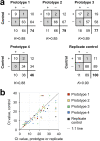Open Development and Clinical Validation of Multiple 3D-Printed Nasopharyngeal Collection Swabs: Rapid Resolution of a Critical COVID-19 Testing Bottleneck
- PMID: 32393482
- PMCID: PMC7383530
- DOI: 10.1128/JCM.00876-20
Open Development and Clinical Validation of Multiple 3D-Printed Nasopharyngeal Collection Swabs: Rapid Resolution of a Critical COVID-19 Testing Bottleneck
Abstract
The pandemic caused by severe acute respiratory syndrome coronavirus 2 (SARS-CoV-2) has caused a severe international shortage of the nasopharyngeal swabs that are required for collection of optimal specimens, creating a critical bottleneck blocking clinical laboratories' ability to perform high-sensitivity virological testing for SARS-CoV-2. To address this crisis, we designed and executed an innovative, cooperative, rapid-response translational-research program that brought together health care workers, manufacturers, and scientists to emergently develop and clinically validate new swabs for immediate mass production by 3D printing. We performed a multistep preclinical evaluation of 160 swab designs and 48 materials from 24 companies, laboratories, and individuals, and we shared results and other feedback via a public data repository (http://github.com/rarnaout/Covidswab/). We validated four prototypes through an institutional review board (IRB)-approved clinical trial that involved 276 outpatient volunteers who presented to our hospital's drive-through testing center with symptoms suspicious for COVID-19. Each participant was swabbed with a reference swab (the control) and a prototype, and SARS-CoV-2 reverse transcriptase PCR (RT-PCR) results were compared. All prototypes displayed excellent concordance with the control (κ = 0.85 to 0.89). Cycle threshold (CT ) values were not significantly different between each prototype and the control, supporting the new swabs' noninferiority (Mann-Whitney U [MWU] test, P > 0.05). Study staff preferred one of the prototypes over the others and preferred the control swab overall. The total time elapsed between identification of the problem and validation of the first prototype was 22 days. Contact information for ordering can be found at http://printedswabs.org Our experience holds lessons for the rapid development, validation, and deployment of new technology for this pandemic and beyond.
Keywords: COVID-19; SARS-CoV-2; diagnostic testing; epidemiology; virological testing.
Copyright © 2020 Callahan et al.
Figures



Update of
-
Open Development and Clinical Validation Of Multiple 3D-Printed Sample-Collection Swabs: Rapid Resolution of a Critical COVID-19 Testing Bottleneck.medRxiv [Preprint]. 2020 May 7:2020.04.14.20065094. doi: 10.1101/2020.04.14.20065094. medRxiv. 2020. Update in: J Clin Microbiol. 2020 Jul 23;58(8):e00876-20. doi: 10.1128/JCM.00876-20. PMID: 32511491 Free PMC article. Updated. Preprint.
References
-
- Johns Hopkins Coronavirus Resource Center. COVID-19 map. https://coronavirus.jhu.edu/map.html.
-
- Thomas K. 2020. The latest obstacle to getting tested? A shortage of face masks and swabs. New York Times. https://www.nytimes.com/2020/03/18/health/coronavirus-test-shortages-fac....
-
- Kodzius R, Xiao K, Wu J, Yi X, Gong X, Foulds IG, Wen W. 2012. Inhibitory effect of common microfluidic materials on PCR outcome. Sens Actuators B Chem 161:349–358. doi:10.1016/j.snb.2011.10.044. - DOI
-
- Bessetti J. 2007. An introduction to PCR inhibitors. Promega. https://www.promega.es/-/media/files/resources/profiles-in-dna/1001/an-i....
Publication types
MeSH terms
Grants and funding
LinkOut - more resources
Full Text Sources
Other Literature Sources
Medical
Miscellaneous

